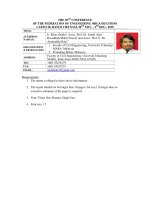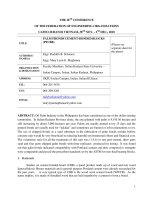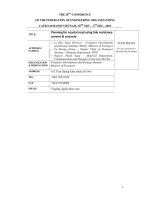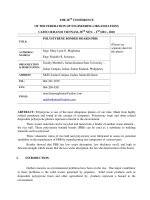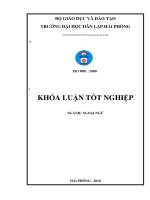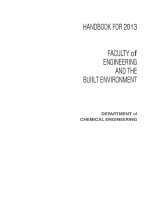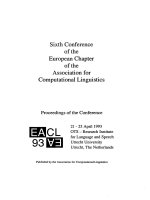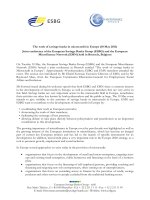THE 28TH CONFERENCE OF THE FEDERATION OF ENGINEERING ORGANIZATIONS
Bạn đang xem bản rút gọn của tài liệu. Xem và tải ngay bản đầy đủ của tài liệu tại đây (942 KB, 10 trang )
1
THE 28
TH
CONFERENCE OF THE FEDERATION OF ENGINEERING ORGANIZATIONS
CAFEO 28 HANOI VIETNAM, 30
TH
NOV. - 2
ND
DEC., 2010
TITLE:
HATSCHEK MACHINE AND EQUIPMENT FOR NON-ASBESTOS FIBER
REINFORCED CEMENT SHEETS
AUTHOR(S)’
NAME(S):
DO QUOC QUANG
ORGANIZATION
&
DESIGNATION:
Research Institute of Technology for
Machinery (RITM), Ministry of Industry and
Trade
ADDRESS:
25 Vu Ngoc Phan, Hanoi, Vietnam
TEL:
+84 - 04.37760155
FAX:
+84 - 04.37762854
EMAIL:
AUTHOR(S)’
NAME(S):
NGUYEN DINH KIEN
ORGANIZATION
&
DESIGNATION:
Institute of Mechanics (IMECH), Vietnam
Academy of Science and Technology
ADDRESS:
264 Doi Can, Hanoi, Vietnam
TEL:
+84 – 4.22428339
FAX:
+84 – 4.37622039
EMAIL:
ABSTRACT
This paper presents a newly developed Hatschek machine and equipment for a complete production
line of non-asbestos fiber reinforced cement sheets. The machine adopted pneumatic mechanism in its
operation shows many advantages, especially the easily assigning of pressure at various important
positions. A set of highly automated equipments for raw material treatment, product forming and de-
moulding and lab test was developed in a simple and environment friendly oriented way. The machine
and equipment have been implemented into a PVA fiber-reinforced cement sheets production line.
After 3 years of operation, the machine and equipment show good performance and efficiency. The
factory products are good in both the mechanical and physical properties, and meet all strict
requirements of the Japanese Industrial Standard JIS A 5430:2004, "Fiber reinforced cement boards".
KEYWORDS:
Hatschek machine; non-asbestos technology; fiber-reinforced cement sheets.
INTRODUCTION
Asbestos cement sheets with good mechanical strength and durability have widely been used for well
over a century. The world top five asbestos users in 2009 are China (565,313 tonnes), India (340,544),
Russia (276,820), Brazil (140,272) and Thailand (102,738) (). However,
2
the hazard of asbestos to human health leads to the ban of using asbestos in construction material
industry in many countries. According to the "International Ban Asbestos Secretariat"
(), until August of 2010 there are 54 countries in the world have banned
the use of asbestos. Among the list, South Korea, Japan, Singapore and Taiwan are four Asian
countries, which have totally banned the use of asbestos. Therefore, the investigation on new fibers
for asbestos substitution as well as development of new technology, including manufacturing process
and equipment for non-asbestos cement sheets, is of great interest of researchers and engineers.
Vietnam is a developing country, and the demand for roofing material, especially the low cost
material increases year by year. According to the statistic data from Vietnam National Roof Sheet
Association, in 2009 Vietnam imported around 64,000 tons of asbestos, mostly for application in
manufacture of corrugated cement sheets. With the data, Vietnam belongs to the most asbestos
consuming countries in the world.
However, being aware of the danger of asbestos, since 2001 Vietnamese government has issued some
decisions to regulate and restrict the use of asbestos in the field of construction material industry. At
the same time, the government encouraged the research on finding fibers for asbestos substitution as
well as development of new methods in manufacturing non-asbestos cement sheets. Since then many
organizations, including the government research institutions and private companies have been highly
paying attention on the topic. In 2003, in a cooperation project between Navifico, a Joint Stock
Company in Vietnam, and Elkem from Norway, the first non-asbestos corrugated cement sheets have
been manufactured in Vietnam (
). However, to the authors knowledge,
due to the low quality of the products as well as the instability and inefficiency of the production line,
Navifico stopped to produce the non-asbestos sheets, just after some trials. In the circumstances, some
foreign companies came to Vietnam and tried to introduce their equipment and technology for making
non-asbestos cement sheets. However, the equipment and technology require a large amount of
investment, which Vietnamese companies can hardly afford.
With some support from government, since 2002 RITM (Research Institute of Technology for
Machinery) started to conduct the research on non-asbestos cement material, in both the machinery
and process technology. The research focuses on the development of new equipment and technology
based on the Hatschek process, which is widely used by Vietnamese fiber cement manufacturers. The
modification of the existing machine and equipment of the asbestos production lines for production of
non-asbestos cement products, both the corrugated and flat sheets, is also of interest. In the research
process, a close cooperation with Japanese PVA fiber manufacturers, namely Kuraray and Dipro
International led to significant results, in both equipment and process technology. As a result, the first
factory for non-asbestos cement sheets was built in Vietnam in 2007. After 3 years of operation, the
machine and equipment show good performance and the products have high quality, which meet all
requirements of Japanese Industrial Standard (JIS A 5430:2004. "Fiber reinforced cement boards").
The objective of this paper is to describe the characteristics of machine and equipment developed by
RITM for production of non-asbestos cement sheets. An emphasis is put on the newly developed
Hatschek machine with highly automated operation. Some aspects of process technology and product
properties are also presented.
HATSCHEK PROCESS
The Hatschek process, invented by Ludwig Hatschek in 1900 and registered as Austrian Patent
number 5970, results in a strong and durable laminate composite material, which has been widely used
as roofing material in many countries around the world. In the process, a slurry with concentration of
about 10% is formed by mixing Portland cement, asbestos and a small percentage of Kraft paper with
water. The slurry is then led to some vats, where the solid materials are taken onto a felt by using
sieve cylinders, which continuously rotate during manufacturing process. The thin lamina of the solid
materials is steadily transferred to a forming cylinder to form a sheet. Until a desired thickness is
3
reached, the sheet is cut and transferred to an area where products with specific geometry are formed
by using some specific equipment. A sketch of the Hatschek machine is depicted in Figure 1.
It is necessary to mention that because of its special physical properties asbestos is easy to disperse in
the cement slurry, especially because of its high specific surface area, asbestos shows excellent
affinity for cement (Hannant, 1978). Other fibers such as PVA fibers do not have such properties, and
many problems, including the fiber balling, delamination and low cement yield, occurred in the non-
asbestos process. As an example, Figure 2 shows a cross section of a delaminated PVA cement
product and back view of a product with fiber balling. The Figure 3 shows another defect easy to
meet - cracks on the PVA sheets. The problem asks, between others, for improvement the properties of
non-asbestos slurry by adding other materials such as silica fume, bentonite, mica, wollastonite,
flocculant...
Figure 1 - Sketch of Hatschek machine
The modification of the Hatschek machine as well as the development of new equipment for treatment
of the above mentioned materials are also required. Thus, the non-asbestos technology is totally
different from both the material and equipment points of view. Some manufacturers were not aware of
the requirements, and tried to produce non-asbestos cement products just by using some new
materials. As a results, the obtained products have very low mechanical strength, and failed to meet
requirements of practice.
Figure 2 – Delaminating and fiber balling PVA cement products
4
Figure 3 - Cracks on the PVA sheets
HATSCHEK MACHINE AND EQUIPMENT FOR NON-ASBESTOS TECHNOLOGY
As above explained, the non-asbestos technology is very different from that of the asbestos one, and in
order to ensure an efficient production line with high quality non-asbestos products, a Hatscheck
machine with new features is required. Since the required pressure at the important positions such as
the making cylinder, couch and breast rollers much depends on the felt speed as well as on the
compositions used, an easy and highly automated control system is desirable. To this end, RITM has
developed a Hatschek machine based on the pneumatic mechanism in its operation. A 3-vats Hatschek
machine for non-asbestos technology, recently designed and fabricated by RITM is shown in Figure 4.
Due to characteristics of the fiber cement production, cleaning, maintenance and sieve mesh changing
is often required at the vat, a simple system for removing the vat manually is adopted for this purpose.
Figure 5 shows the detailed system of the manually removable vat.
In general, the Hatschek machine for PVA cement production is very similar to that of the asbestos-
based one, from outside appearance, at least. However, many features of the non-asbestos machine are
different from that of asbestos machine. The speed of agitators at the vats should be adjusted to assure
that the PVA fibers are properly dispersed in the cement slurry, and the solid materials are be able to
stick on the cylinder meshes. The pressure at the formation cylinder and rollers should be controlled as
well as the green sheet should not be over dried, which could cause difficulties in the forming stage.
Many other machine parameters also require to be properly adjusted.
Figue 5 – Vat removing system of
RITM Hatschek machine
Figue 4 – A new Hatschek machine
developed by RITM
5
Table 1 – Common materials used in production of PVA cement sheets
As already mentioned above, different from the asbestos technology, in addition to the Portland
cement and fibers for reinforcement, the non-asbestos technology requires a wider set of different raw
materials in its production for improving the production process as well as the properties of final
products. The function and effectiveness of these raw materials are different. Table 1 lists some raw
materials commonly used in production of PVA cement sheets as well as their respective function and
performance (effectiveness).
The additional raw materials such as that listed in Table 1, however are not ready for application in the
Hatschek process and pre-treatment of the materials is required. Thus, in order to produce the non-
asbestos products in general and the PVA cement sheets in particular, a set of new equipment for
treating these raw materials has to be developed. The equipment should be designed in way it can treat
the materials properly and efficiently, but without expanding the production line too much. Among the
additional materials, the treatment of Kraft pulp is the most important, and it requires strict control.
The fineness of the pulp after treating plays an important role in the non-asbestos production process.
Figure 6 depicts the equipment for pulp refining, as designed and fabricated by RITM.
THE FIRST VIETNAMESE NON-ASBESTOS PRODUCTION LINE - A CASE STUDY
PVA production line
Based on the machine and equipment research and development for the non-asbestos technology at
RITM, in 2007 a joint project between RITM, Kuraray of Japan and Dipro International resulted in the
first production line for PVA cement corrugated sheets in Vietnam. The production line was built at a
factory of TTC Joint Stock Company, a company located in the Northern part of Vietnam. All the
Hatschek machine and equipment implemented at TTC have been fabricated by RITM. For the first
step, the factory aims to a capacity of 2 millions square meters of cement sheets per year. A view of
the production line with main equipment is depicted in Figure 7. The production line can produce flat
sheets also. The difference in the production of the corrugated and flat sheets is in the forming and
No. Material Function Performance (Effectiveness)
1 Portland cement
(already in asbestos process)
Binding agent Strength of matrix, binding composite
2 PVA fibers (f.e.
KURALON)
Reinforcement,
asbestos
substitution
High bending strength & impact
strength
3 Wollastonite, mica
(additional)
Stabilizer Dimensional stability, preventing crack
formation
4 Silica Fume
(additional)
Filler Densification of matrix, control
gravity, better bonding between fibers
and matrix, better appearance
5 Attapulgite, Bentonite
(additional)
Improvement of
Forming
Improvement of productivity, layer
adhesion
6 Polyacrylamide
(additional)
Agglutinate
Agent
Improvement of Productivity
